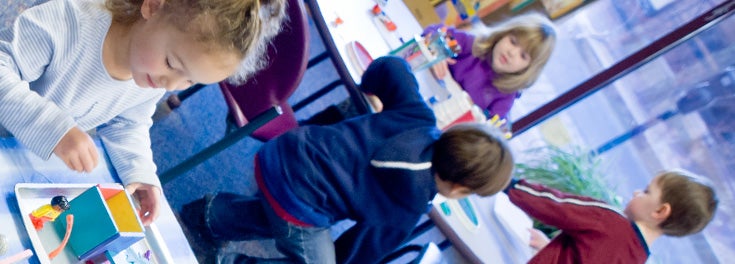
Picture yourself in the center of a classroom. You are transforming youngsters into successful learners. Then consider the reality of teaching a few dozen kindergarteners, each with their own personality and way of learning.
“Learning about teaching in an academic classroom gives you a lot of theory and ideas about how to run a classroom,” said Susan Warford, director of the University’s Child Development Center (CDC), “but until you have children in front of you and engage with those real children, you really can’t know anything about classroom management.”
How is the URI Child Development Center experience good for the children and good for the college students? By putting you in the center of the classroom, not as an observer, but as a teacher.
A magnet for aspiring teachers, our CDC is where you will get that hands-on experience. It’s one of only a handful of preschools in the country to earn the prestigious National Accreditation for the Education of Young children. And it’s where you’ll progress from a student learning about education and observing youngsters, into a teacher developing and carrying out lesson plans and changing lives.
The CDC is one reason why senior Amanda Andersen ’13 chose URI, and her experience here has shaped the kind of teacher she will be. “I spent my summer and winter breaks working at the CDC because I love everything about the program,” Amanda said. “I never knew it was possible to learn so much from a job, and also love a job as much as I have loved my job at the CDC.”
If you major in Human Development and Family Studies, as Amanda does, you’ll take two courses at the Center. An introductory course highlights working with children and learning by observing the classroom setting. The second allows you to plan and implement activities based on theories from your coursework.
“At the CDC, I discovered my personal teaching style and the kind of teacher I strive to be,” said preschool teacher Lexi Zambino ’12. “Working there prepared me well for working in another school, therefore, the transition was rather easy. It allowed me to step right into my new role with professionalism, skill, and confidence.”
The student experience of moving theory to practice makes the CDC ideal for experiential learning, says Kim Washor, director of URI’s Office of Experiential Learning and Community Engagement. “It brings the curriculum to life for the college students and the children, as I have seen first hand,” said Washor, whose five-year-old daughter attends the Center. “One student developed a lesson around science because my daughter always wants to know how things work. She recognized that, took the knowledge from the class, and applied it to creating something that was special for my child.”
For Alix Moffatt, the Center’s a family thing. A URI Transition and Retention Advocate, Moffatt attended the Center as a child and sent her sons there too. “I wanted them to go to a place where you have people who care so much about child development and about how to teach people to educate children.” Now in high school, her sons insist the CDC was their best educational experience.
“We are in a constant state of program improvement,” said Warford, who’s been at the CDC for 26 years. “We’re always asking, ‘how is this experience good for the children and good for the college students?’”
We make it good by putting you in the center of the classroom, not as an observer, but as a teacher. “The CDC teachers truly set you up to succeed and better yourself for the future,” said future teacher Amanda.
Related Links:
National Association for the Education of Young Children
Photo: Children at the Child Development Center at URI’s Providence campus.
